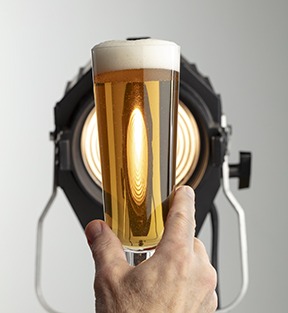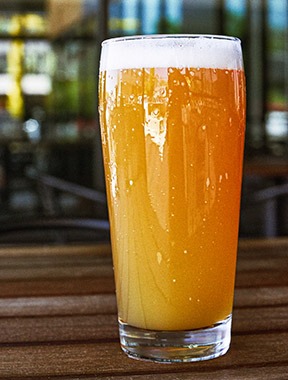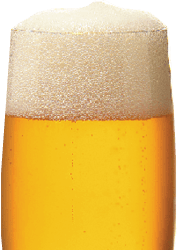Clearing Things Up
rystal clear beer is the goal for most beer styles, and commercial brewers go to great lengths to assure both clarity and stability in their finished beers. In fact, many consumers perceive hazy beer to be contaminated or of poor quality, and most beer judges are quick to mark down a hazy lager or clouded pale ale. Despite the rise of hazy IPAs, most beer lovers still treasure a crystal clear beer.
Understanding Haze and Measuring it in Beer

Haze itself comes from suspended particles within the beer that reflect light. These particles can come from a variety of sources including proteins, polyphenols/tannins, yeast cells, bacteria, foreign material, and even excessive finings. The most common forms of haze come from proteins, polyphenols, and yeast cells.
While many consumers think of hazy beer as contaminated or of poor quality, the particles that form haze are largely without flavor. So removing the cloudiness from a beer will not significantly change its
flavor profile.
You can measure beer haze using a haze meter. These devices take a small sample of beer and shine light through it at a specific wavelength and then measure the intensity of light reflected off the particles. Haze is most often measured on EBC (European Brewery Convention) and NTU (Nephelometric Turbidity Unit) scales.
Since few homebrewers have access to a haze meter, we instead rely on our eyeballs. Pour your beer into a very clean glass and hold it up to the light. Is it crystal clear or is there some distortion or cloudiness? Also, does the cloudiness change as the beer gets warmer, which would be an indication of chill haze.
Chill Haze and Permanent Haze
Haze can manifest itself in two ways: Chill haze and permanent haze. Chill haze is a cloudiness that occurs when the beer is cold but slowly disappears as the beer is warmed up to room temperature. This happens because some haze-active proteins and polyphenols form weak bonds with one another at cold temperatures that result in visible haze, but these weak bonds dissolve at room temperature and the haze disappears.
The other type of haze is permanent haze, which is present and unchanged at all temperatures. It is very common for a chill haze to become a permanent haze over time, so we try to mitigate both types of haze when brewing and packaging our beer.
Causes of Haze in Beer

The primary cause of haze is from proteins and polyphenols (tannins) that come from malts and hops. These two ingredients cause the vast majority of both chill haze and permanent haze problems in finished beer. Yeast can also affect the clarity of your beer, but yeast does tend to drop out of suspension as the beer ages.
Other causes of haze that are less common include:
Bacterial infection, which can leave dead bacteria cells in the beer. This would be easy to detect as it would also sour the beer.
Damaged or overstressed yeast, which can leave longer chains of carbs and proteins in the beer.
Calcium-deficient worts, which lead to oxalates forming in the beer.
Wheat-derived adjuncts, which add pentosans, as well as protein, causing haze.
Inadequately modified malts leaving beta-glucans in the beer. This is uncommon with modern malts, which are all highly modified.
Lubricants, excessive finings, or other foreign material in the beer.
With the exception of wheat, which will often create clarity issues for the homebrewer, the other causes above are uncommon at the homebrew level. Assuming you use fresh ingredients, follow good sanitation procedures, and follow good brewing practices, you should not have these issues in your finished beer.
Yeast Clarity Issues in Beer and Mitigation
Since yeast is the easiest clarity issue to manage, I will cover it first. The average yeast cell is 5–10 microns in size, which is certainly large enough to cause haze issues in your finished beer. After fermentation, your beer will be hazy because active yeast cells are in suspension.
Once fermentation is done, the yeast will flocculate, or fall out of suspension, and form a layer at the bottom of your fermentation vessel. Different yeast strains have different flocculation rates, which you can find on the yeast data sheet from the manufacturer. “High” flocculation yeasts will fall from suspension quickly while “low” flocculation yeasts can take weeks or even months to clear.
Most fermentation finings work well with yeast, so adding any common brewing fining after fermentation will increase the speed of flocculation. Cold crashing your beer will also make the yeast fall from suspension faster so that is another method to increase flocculation. Finally, filtering can remove all the yeast from the finished beer, so that is another method to consider.
Because yeast cells are relatively large, and can be removed by chilling, finings, and filtering as well as through time, they rarely cause a long-term clarity problem. They are primarily an issue in young beers, or for commercial brewers who need to get their product out the door as quickly as possible.
Haze and Chill Haze From Proteins and Polyphenols
Proteins and polyphenols are the centerpiece of most long-term clarity issues in beer, both for homebrewers and at the commercial level. Proteins are a natural component of malted barley. Wheat, oats, and other non-barley adjuncts also have high percentages of proteins, so you need to be careful when using large percentages of those adjuncts. However, proteins also play an important role in providing body to the beer and also promote head retention, so some protein is important for a balanced beer.
Polyphenols, also called tannins, are the other leading cause of haze. The majority of polyphenols come from malted barley, primarily the husks of the grain itself. These are extracted during mashing and present in all beers. Hops also account for about 20–30% of the polyphenols in beer and can be a larger contributor in very hoppy beers like IPAs.
The problem with chill haze is that these weak bonds are prone to polymerization, often aided by tiny amounts of oxygen and reactive metal ions in the finished beer. When this occurs, the chill haze may become a permanent haze. So our goal as brewers is to minimize both chill haze, metals, and oxygen in the finished beer to avoid the formation of permanent haze.
Ingredient Selection to Minimize Haze
You can reduce the chance of haze from proteins in your beer by carefully selecting your malts. The protein percentage is included on the specification sheet from the maltster, so you can intentionally select lower protein malts if you are making a very light colored beer where clarity is important. Most maltsters have their specification sheets available online so it is simply a matter of looking up each grain and being judicious in selecting those with lower protein content.
Adjuncts like wheat and oats have very high percentages of proteins, so you need to minimize the use of these adjuncts if clarity is your primary goal. As with barley malts, most malt suppliers will publish the protein percentage for adjuncts, so you may want to select carefully or avoid certain adjuncts altogether if clarity is an important goal.
I mentioned earlier that hops account for up to 30% of the polyphenols in beer, and in some IPAs the percentage can be even higher. Hop polyphenols primarily come from the leaf. Less leaf material is used for a given bitterness or oil level when using high alpha/high oil hops. I personally don’t consider polyphenols as a more important factor than flavor and aroma when selecting my hops, but it is something you might want to consider if making a very hoppy beer.
It might be best also to avoid overhopping your beer. Some brewers come out with IPAs in the 100+ IBU range when in practice our senses max out somewhere in the 60–80 IBU range, and anything beyond that is simply perceived as really bitter. Beyond that range you are really just adding vegetal material and flavors (i.e., polyphenols) to the beer and not increasing the perception of bitterness.
Improving Clarity in the Mash and Sparge

In addition to careful ingredient selection, there are several opportunities during the brewing process to enhance the clarity of your beer, starting with the mash.
We can start with the correct grain crush. The grains should be milled in a way that keeps most of the husks intact while crushing the interior of the kernel. These husks will form a nice filter bed when sparging, which will aid in extraction.
I have found if I over crush my grains, as I did recently with a new mill, it can lead to clarity issues in the wort and beer. The reason for this is that most of the tannins extracted from the grains come from the husk. If your grains are properly crushed, those husks form a filter bed and are largely left out of the wort itself. When the crush is too fine, bits of the husk can get into the wort and the boil, leading to excessive tannins being extracted and clarity problems.
The next item to consider is your mash pH, which should be adjusted with lactic or phosphoric acid if necessary to be in the 5.2–5.6 range during the main conversion step. While the mash pH does not directly impact the clarity of the beer, pH can impact clarity indirectly during the sparge in several ways.
The first is the potential for excessive tannin extraction. Tannins are a weak acid, but in the presence of high pH wort they can lose an additional proton and become negatively charged. When this happens the water is a great solvent and starts to pull tannins into the wort during the sparge. So the solubility of tannins increases with mash pH.
The pH threshold for sparging at the professional level is 6.0, so most pro brewers will stop sparging when the pH of the runnings exceeds 6.0. However, if you don’t adjust your mash pH up front and start with a high mash pH of something like 5.8, you will quickly be in the danger zone during the lautering process as more and more slightly alkaline water increases the pH over time. So to avoid excessive tannins you do want to control your mash pH up front.
You can also reduce the pH of the runnings by treating your sparge water with a small amount of lactic acid. This will reduce the pH of the water as it is filtered through the grain bed. Because you don’t need to offset the buffering capacity of the grain, less acid is needed than in the mash itself. There are a variety of calculators and brewing software that can aid you in estimating the correct amount of acid needed to buffer your sparge water.
A proper wort pH also aids in protein coagulation during the boil. Lower wort pH will aid in creating the hot break, which is the layer of protein that forms at the beginning of the boil. It also helps additional proteins coagulate and fall out during the boil.1
Another process factor to consider is the clarity of your mash runnings. A good rule of thumb is that you don’t want to disturb the grain bed once you have started to sparge. If you have a recirculating pump you keep on during the mash, again try not to disturb the grain bed once it has been set up.
The husks from the grain should set up a nice filter bed with lots of channels in it so you get good extraction without pulling a large amount of grain or husk material into the wort. Stirring or disturbing your grain bed can lead to turbidity and cloudy wort, which will contain more tannins and have less clarity. Strive for clarity in the runnings.
Improving Clarity in the Boil

You can also take steps to improve clarity in the boil. When the boil begins, the “hot break” forms at the top of the wort. It is an oily-looking layer you will see right as the boil starts. The hot break is a layer of coagulated proteins, so some brewers take the extra step of skimming those from the top of the wort to eliminate their presence in the beer.
Next you want to set up a strong rolling boil. A vigorous boil removes unwanted volatiles from the wort, but also aids in precipitating unwanted proteins and tannins. Ideally you want a boil that has constant motion and not just a few bubbles coming up from the bottom. If you want to take the extra step of measuring your boil-off you can monitor your volumes over time and calculate a boil-off rate and then adjust your heat source. For a homebrew system, most brewers target a boil-off rate of around 15% per hour.
A long boil (90 minutes is ideal) will also aid in the precipitation of proteins and tannins. A wort boiled for 90 minutes will certainly produce a clearer beer than one boiled for 30 minutes. A long boil has the side benefit of reducing off-flavors from volatiles like Dimethyl Sulfide (DMS) as well.
Another area for improvement is in reducing hot-side aeration. Hot-side aeration simply refers to introducing oxygen into the wort while the wort is hot, which can have adverse effects on the clarity and stability of the finished beer. While hot-side aeration is not a huge factor for most homebrewers, I do try to avoid splashing the wort or introducing oxygen during hot transfers when boiling.
You have the opportunity to introduce kettle finings near the end of the boil. The most commonly used kettle finings are Irish moss or Whirlfloc. Irish moss is actually a red seaweed called Chondrus crispus that contains an emulsifying agent called carrageenan that is widely used as a thickener for low-fat food products. Whirlfloc and similar kettle finings are also rich in kappa-carageenan, but are extracted from farm-raised Euchema cottonii primarily grown in the Philippines. Kappa-carageenan from both sources has a polarized charge that attracts proteins and tannins in the wort and creates larger molecules of sediment that then precipitate out of the wort.
Irish moss is basically the dried seaweed, while Whirlfloc has the same active carrageenan compound but in a tablet form. Both are added about 15 minutes before the end of the boil, and quite often you can see the proteins coagulating at the top of the wort shortly after you add them.
After Boiling: The Cold Break
You should use a wort chiller of some kind to cool your wort as quickly as possible after boiling. The rapid drop in temperature will result in coagulation of proteins, hop polyphenols, tannins, bits of grain, and vegetal hop matter from the wort. This “cold break” (aided by the use of kettle finings) will form a substantial layer of sediment at the bottom of the boil kettle. It starts forming around 140 °F (60 °C) and continues to precipitate out as you chill the wort down to fermentation temperature.
An effective cold break promotes clarity but also aids in flavor stability in the finished beer. If you use an immersion chiller you have the added benefit of being able to leave a lot of the cold break in the boiler. Commercial systems use a whirlpool action in the boiler to leave much of the cold break behind before chilling and transferring to the fermenter. If you have a homebrew system with a simple plate chiller, you will end up with some break in the fermenter, but the break is unlikely to re-combine with the wort at fermentation temperatures. If you have a conical fermenter, you can draw the sediment off early in the fermentation.
Lagering and Cold Crashing
Once fermentation is complete you may want to consider cold storing or cold crashing your beer. This is done by lowering the temperature to just above freezing. Cold crashing will quickly precipitate out the yeast from fermentation but also will remove many of the proteins and tannins remaining in the beer. Cold crashing is also a great way to prepare your beer for filtering.
If you can, age (lager) and store your beer cold as cycling beer between warm and cold will increase the chance of chill haze becoming a permanent haze (not to mention rapidly aging your beer).
Fermentation Finings
A large number of finishing finings are available to the homebrewer to be added a few days before bottling or kegging your beer in order to allow the fining sufficient time to bond with the haze and drop out of solution. These all work in the same basic way. They are all positively charged molecules that attract charged proteins and tannins; forming larger particulates that then settle out of the beer. Here are some of the most widely available:
Unflavored Gelatin – One of the cheapest effective finings, you can find unflavored gelatin near the “Jell-O” section in your local grocery store. Dissolve 5 oz. (140 g) gelatin in ~10 oz. (280 g) of hot water for every 5 gallons (19 L) of wort to reduce both proteins and tannins in your finished beer.
Polyclar (PVPP) Plastic – Polyclar is a polymer-based powder that is positively charged and resembles protein. It can be found at most homebrew shops and 1 tablespoon for every 5 gallons (19 L) of beer is effective against polyphenols, proteins, and tannins.
Silica Gels – These are sold under a number of brand names such as Britesorb and often used with wines. The gels are very effective at binding proteins and improving clarity. The typical dosing rate is 5–10 grams per 5 gallons (19 L) of beer, but read the directions on the package as some gels contain varying amounts of silica.
Silica Sols – These compounds are a suspension of colloidal silica sold under different trade names such as Biofine Clear. Added late in the boil or during aging, silica sols absorb proteins to improve clarity. Read the directions from the manufacturer for dosing rates.
Isinglass – This is piscine collagen that is derived from fish bladders. Isinglass has been used for a very long time by brewers and winemakers. It is effective at removing proteins and yeast cells, and also removes some lipids (oils), which will improve head retention.
Papain – This is used extensively in winemaking. It has fallen out of favor for use in beer, however, as it negatively impacts foam stability.
Filtering Your Beer
Filtering is widely used by commercial brewers where it is cost-prohibitive to allow beer to sit and clear for an extended period while taking up tank space, and removing the remaining yeast cells is often needed to prevent further fermentation in the bottle. Filtering is also an option at the homebrew level. Most of the larger homebrew suppliers offer filtering equipment, which most often is done while transferring between two kegs.
The best type of filter to use is a two-stage filter. Typically the beer is run through a 5-micron filter size to take out large particles. Many brewers stop there, but others who want to remove all the yeast and finer particles will do a two-stage filtration by then running the beer through a 1-micron or even 0.5-micron size filter.
Filtering should be done when the beer is cold as any chill haze molecular bonds are already formed, so the larger chill haze particles can be filtered. Filtering can remove all of the remaining yeast cells and virtually all of the visible haze in a beer.
Summary
Clarity in beer starts with good ingredient selection. If you are making a particularly delicate lager, you should select malts with lower protein levels, and also hop appropriately. When brewing, mash and sparge in the 5.2–5.6 pH range and don’t allow your sparge runnings to rise above 6.0 pH. Continue into a long, vigorous boil, and add boil finings such as Whirlfloc or Irish moss at the end of the boil. Chill your wort quickly to get a good cold break, and then pitch enough yeast and ferment properly. Add fermentation finings a few days before bottling or kegging your beer. Consider cold crashing your beer and store it cold, if possible. Finally, filtering is an option if you are striving for the highest levels of clarity.
References:
1 Briggs, D. E. (2011). Brewing: Science and Practice. Woodhead Publishing.



